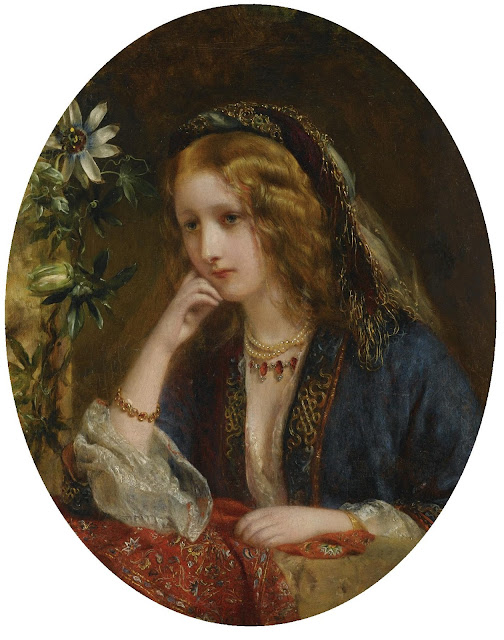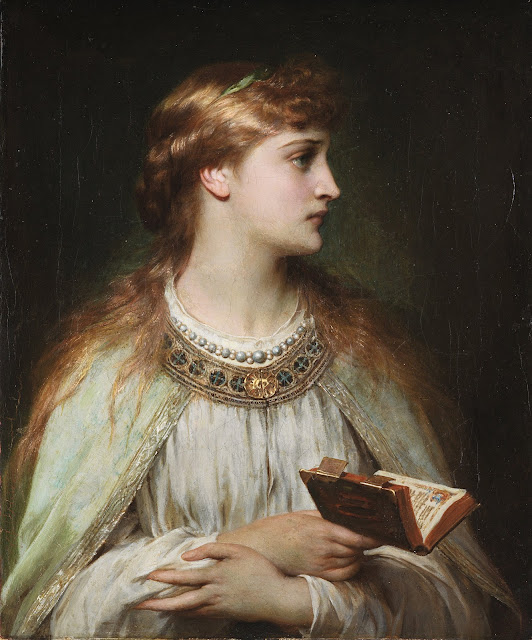Frank Dicksee Story Paintings Review
http://phistars.blogspot.com/2015/09/frank-dicksee-story-paintings-review.html
Frank Dicksee Story Paintings Review
by Teresita Blanco
Beatrice 1888
Beatrice was a popular subject during the 18th and 19th century. Beatrice was the muse of Dante. He loved her because she did not love him. When he was in exile, Dante wrote about her instead of his wife. Dicksee focused on her humane beauty. She almost looks idealized.
Juliet 1877
O Romeo, Romeo, wherefore art thou Romeo?
Deny thy father and refuse thy name;
Or if thou wilt not, be but sworn my love
And I'll no longer be a Capulet.
This painting shows the moment when Juliet was sighing over Romeo. She wanted him to give up his name. His name was the reason why they could not marry. If he would not, she would marry into his family. Juliet thinks that if both resign their family names, then they could be together, forever. This was one of the most popular scenes of Shakespeare's play. Here, Juliet looks adorable illuminated by the moonlight.
Juliet
Here is another depiction of Juliet. She has an oriental look. She was in a masquerade when she met Romeo. As such, Dicksee dressed her up in a period costume.
Miranda 1895
Miranda was the daughter of the mage Prospero. She is the only female character in Shakespeare's The Tempest. She was banished to an island, along with her father. She lived alone with her father and their slave for 15 years. She knew nothing of the outside world. Here, she is depicted in all her radiance and innocence. Miranda is the perfect example of how Victorian women should behave. She was obedient and compassionate.
Paolo and Francesca 1894
The pair appeared in Dante's Inferno. They were in the second level of hell. Paolo and Francesca were married to someone else. They still managed to carry on an affair for 10 years. When Francesca's husband found out, he killed his wife Francesca and his brother Paolo. This tragic love romance happened while Dante was alive. It was a big deal during the medieval era. For that reason, he included the pair in his poem.
Romeo and Juliet 1884
In this scene, Romeo and Juliet are parting ways after spending the night together. This was the last time they were truly happy.
La Belle Dame Sans Merci Poem
O what can ail thee, knight-at-arms,
Alone and palely loitering?
The sedge has withered from the lake,
And no birds sing.
O what can ail thee, knight-at-arms,
So haggard and so woe-begone?
The squirrel’s granary is full,
And the harvest’s done.
I see a lily on thy brow,
With anguish moist and fever-dew,
And on thy cheeks a fading rose
Fast withereth too.
I met a lady in the meads,
Full beautiful—a faery’s child,
Her hair was long, her foot was light,
And her eyes were wild.
I made a garland for her head,
And bracelets too, and fragrant zone;
She looked at me as she did love,
And made sweet moan
I set her on my pacing steed,
And nothing else saw all day long,
For sidelong would she bend, and sing
A faery’s song.
She found me roots of relish sweet,
And honey wild, and manna-dew,
And sure in language strange she said—
‘I love thee true’.
She took me to her Elfin grot,
And there she wept and sighed full sore,
And there I shut her wild wild eyes
With kisses four.
And there she lullèd me asleep,
And there I dreamed—Ah! woe betide!—
The latest dream I ever dreamt
On the cold hill side.
I saw pale kings and princes too,
Pale warriors, death-pale were they all;
They cried—‘La Belle Dame sans Merci
Hath thee in thrall!’
I saw their starved lips in the gloam,
With horrid warning gapèd wide,
And I awoke and found me here,
On the cold hill’s side.
And this is why I sojourn here,
Alone and palely loitering,
Though the sedge is withered from the lake,
And no birds sing.
This painting shows Keats' femme fatale. The knight fell in love with the fay woman. However, it was in her nature to kill all the men that fell in love with her. This pattern was common to most fay romances with humans. The knight was able to escape the fay woman because the ghosts of her previous lovers warned him. In the end, he regretted running away from the fay woman.
Ophelia
"There's rosemary, that's for remembrance. Pray you, love, remember. And there is pansies, that's for thoughts," said Ophelia to her brother Laertes. "There's fennel for you, and columbines. There's rue for you, and here's some for me; we may call it herb of grace o' Sundays. O, you must wear your rue with a difference. There's a daisy. I would give you some violets, but they withered all when my father died."
Ophelia was the potential wife of Hamlet. She is also one of two female characters in the play Hamlet. Ophelia went mad because Hamlet had killed her father Polonius. Ophelia gave herself the flowers of Rue. Historians wondered why she had such a flower. Rue had abortive properties. According to Ophelia, rue was a herb of grace. She wore it to symbolize her disgrace. She had fallen in love with the man who had murdered her father.
In the first painting, she appears near the willow tree. She had fallen from it resulting in her early demise. During her funeral, the priest thought she had killed herself. However, her brother Laertes said it was an accident. The second painting shows Ophelia back when she was remotely lucid. She is reading a medieval Bible. Overall, Dicksee's paintings were rather pretty.











